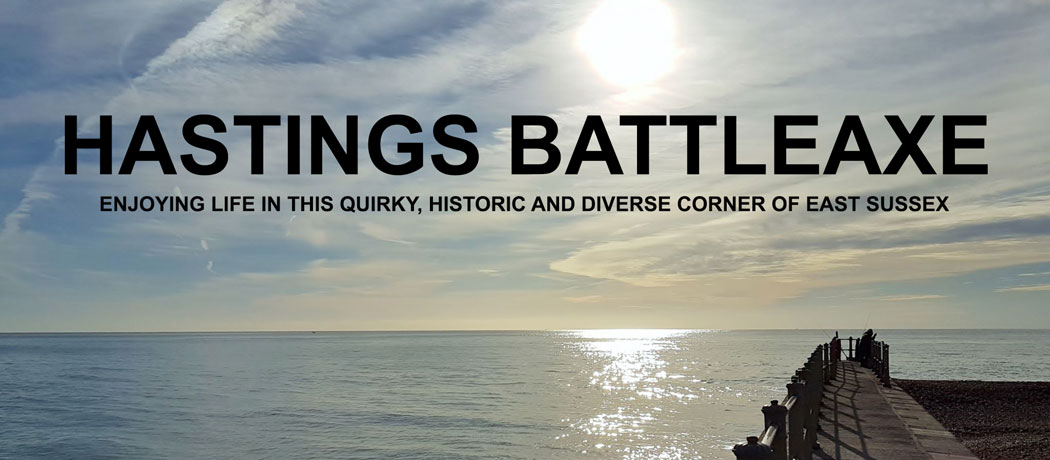Well, not literally. For the next Stanza poetry meeting, Smugglers is the suggested theme. We don’t necessarily have to follow the suggestion, but this time is slightly different. I don’t know the exact details, but the Hastings Smugglers’ Adventure Caves want poems about smuggling for an event later in the year. The poetic muse has abandoned Battleaxe at the moment, so I thought I’d write a bit about Hastings Smugglers to focus my thoughts.
 |
| The Smugglers’ Adventure Caves |
 |
| The Caves – try hard to be spooky. |
Well, firstly, the Caves. Although the St Clements’ Caves were presumably the haunts of smugglers they are very ancient and their origin is obscure. They were a Victorian tourist attraction – dances were held down there (presumably for revellers who couldn’t face puffing up to dance at the Clive Vale tea garden – see previous posts) – and they were used as an air-raid shelter and hospital in WW2. Now, it is all spooky Smugglers’ Adventure.
Battleaxe has only been there once, many years ago, when Grand Daughter was very small – her first visit to Hastings. Just a momentary deviation here …. When she visited again, we unwisely gave her the choice of revisiting the Caves or playing in the West Hill playground. She chose the playground. Being the sort of child she is, visits to the playground inevitably ended in tears. That time, we we dragged her out weeping as usual. Some yobs lurking in the shelter accused us of child abuse…. By then thoroughly overwrought, GD announces she wants to go to the Caves. We say, no, you made your choice. Next thing, we are faced with total, epic, shrieking melt-down. We walked along Priory Road with her screaming like a banshee. Some old geezer sitting outside the Plough nearly died of a heart-attack.
Back to the Caves. It’s quite a good visit for folk with kids but not much more. It presents pretty much the jolly image of old-style smuggling. Think tunnels, churchyards and caves, kegs and casks, lanterns winking on the clifftop, ponies with muffled hooves, bare-chested Poldark down and dirty on the beach etc.
Hastings Old Town is a good breeding ground for smuggling tales, with its narrow streets and twittern alleys. Two old pubs, the Stag in All Saints Street, and the Hastings Arms in George Street are reputedly smugglers’ haunts.
 |
| Hastings Old Town – St Clement’s Church |
The ‘romantic’ image of smuggling was popularised by artists like George Morland:in the eighteenth century – these two Morland paintings are typical. (Blimey, Morland lived a dissipated and rackety life. He apparently died in a ‘sponging-house’. What’s that? No idea. No sooner do you Google one thing than you are faced with another question).
 |
| Smuggling scens by George Morland |
The real story is much rougher and tougher.
In Hastings, ‘Ruxley’s Crew’ were a thoroughly unpleasant gang active in the 1760s. They didn’t just smuggle, but would board and capture ships in the channel, kill the crew and seize the cargo. One time they attacked a Dutch ship and attacked the captain so savagely that they split his spine with an axe. This led to the notoriously violent Hastings smugglers being known as ‘chopbacks’.
 |
| Hastings Chopbacks |
In 1821 the local population rioted after an exciseman who had shot dead Joseph Swaine, a local fisherman, was reprieved rather than being hung for murder. Dragoons had to be sent to the town to restore order.
Hastings people, and in particular, the fishing community, have always been minded towards doing their own thing. In the eighteenth and early nineteenth centuries, smuggling was an assertion of ‘traditional’ freedoms and rights. The indigenous fishermen were used to handling
small boats in difficult conditions, and smuggling provided better earnings than their legitimate trade.
The Bo-Peep area in West St Leonards was the first place in England to have a coastguard service, set up to protect shipping from savagery of the local population. ‘Little Bo-Peep’, the nursery rhyme, is believed to have a hidden meaning related to smuggling…..
However, some smuggling was organised crime on a much larger scale. The Hawkhust Gang had a sophisticated communicatons network to transport goods from the ports of Sussex and Kent to London. They were extremely violent, beating to death anyone they suspected of betraying them or stealing contraband.
All very interesting, but not providing any poetic inspiration.
Perhaps modern smuggling might be better. Human trafficking, desperate migrants, drug smuggling – all prevalent along our local coast, but it is unlikely that any of those activities will be given a romantic glow any time soon….
Have been at my sister’s in Bedford this weekend – will do a post about a lovely garden we visited.




Comments from Google+